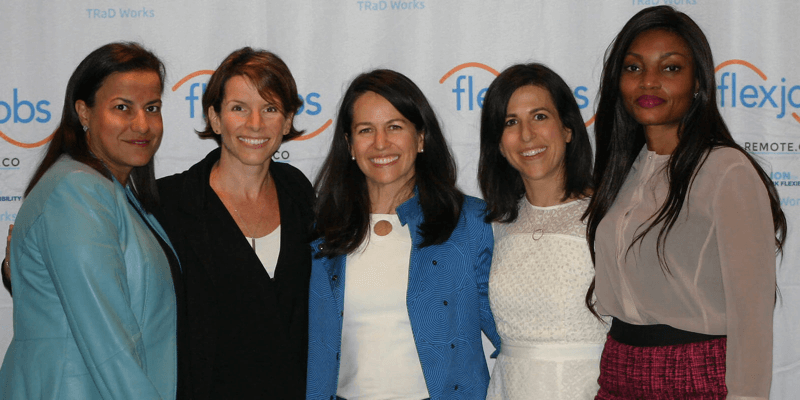
Updated on: April 4, 2019
2017 TRaD Works Forum: 12 Takeaways for Remote Workers and Managers
Remote.co and FlexJobs recently held their second annual TRaD Works Forum in Washington, DC. The event, which focuses on telecommuting, remote, and distributed work, lasted two days and hosted about a hundred thought leaders, journalists, executives, HR professionals, and supporters.
The jam-packed agenda included keynotes, panels, and round-table discussions on topics such as talent attraction and retention, TRaD work tools and platforms, the global impact of work flexibility, the power of communication in a TRaD workforce, and the future of work, among others.
To kick off the event—which was sponsored by Dell, Cisco, and Morgan Lewis—Sara Sutton, the CEO and founder of Remote.co and FlexJobs, interviewed Robert E. Kelly via Skype. Also known as “the BBC dad,” Kelly is a political analyst and professor who’s March 2017 BBC interview went viral, thanks to his adorable children bursting into his home office mid-conversation. (You can watch the video and some follow-up here.)
During his chat with Sutton at the TRaD Works Forum, Kelly asked a question so many remote workers struggle with: when you’re a parent who works from home with young children, should your office be off-limits to them? Or do you want them to feel comfortable coming into that space? What types of boundaries should you set for your family as a remote worker?
So, the first takeaway that was discussed was: as soon as you begin working remotely, or once you have children, think about the boundaries you want to set, and enforce them. While there’s no right or wrong approach, as this can be a personal preference, it’s important to make a decision and set expectations.
Here are 11 more key takeaways from the 2017 TRaD Works Forum:
Remote work is, in fact, on the rise.
But it’s not just when, how, and where we work that is changing. Why we work—the value we place on work—is also evolving, explained Vipula Gandhi of Gallup during her keynote talk. If employers don’t learn to understand and meet their employees’ needs, the employees won’t be engaged. And when workers aren’t engaged, it can spread negativity across the organization, which can kill morale and create a bad culture.
As a manager, it’s important that you allow your talent to work in the environment in which they are most productive and efficient—which means you need to be flexible.
But flexibility can’t be a special treat for some and not for others. You need to offer it to everyone. If someone’s job can’t be done remotely, tweak it so it can be. Make everyone feel trusted. This will allow your staff to feel engaged. And remember: don’t take away choices or force anything. If possible, give everyone the ability to choose how or where they can most successfully get their work done.
Remember that flexibility means something different to every person.
While hiring, it’s important that you’re clear on the type of flexibility you offer, so there is no confusion later on.
Physical distance has very little impact on meaningful relationships.
You can, and should, have strong connections with virtual colleagues. But first and foremost, there needs to be trust. You must also be an empathetic and intentional leader who makes a valiant effort to restore shared context. In other words, remind employees that despite our unique situations and physical workspaces, and everything else that makes us different, we’re all in the same boat as remote workers. Share stories with these people. Ask questions. Get to know them. Be human. Everyone wants to know they are cared about—and when they do, you’re able to create a bond that’s necessary to thrive in this (or any) type of work environment.
Technology plays a big part in remote work.
You have to find the right tools and platforms that offer employees what they need (to perform most efficiently) and want (i.e., the spontaneous engagement they miss when they’re not in an office; efficient communication; etc.). But remember, the shiniest and most expensive tools aren’t always the best option! Also, be sure to limit the number of tools you use, but offer some options. You don’t want to assume one-size-fits-all when it comes to technology.
Once you implement these tools, ask yourself: “Did it help me accomplish what I wanted to? Did I and/or my colleagues enjoy using it? And was it easy to use?” You should answer yes to all of the above.
For so many, remote work means opportunity.
In a discussion about the global impact of TRaD work, panelists Manar Morales of The Diversity & Flexibility Alliance, Marcela Escobari of Brookings Institution, Ronit Avni of Localized, Tolu Olubunmi of the World Economic Forum, and Sara Sutton (all pictured above), explained that remote work offers people in rural and/or impoverished communities around the world the option to work from where they are, when there may be very few local professional opportunities. When this happens, it ends up impacting the rest of their community in a positive way (they bring in Internet, technology, money, etc.). These people also become role models, or inspiration, to the rest of the community. They are a living, breathing example for those around them of what is possible. And this can create an incredibly positive cycle.
Intentional communication is key to a successful remote workplace.
Whether you’re a manager or employee, you need to be an excellent communicator. When people communicate well in a remote environment, work gets done.
During their panel on the power of transparency and communication in a TRaD workforce, Know Your Company CEO Claire Lew, Harvard Business Review editor Amy Gallo, and The Smart Workplace co-founder Trina Hoefling discussed the importance of open, authentic, and frequent communication. First and foremost, they explained, you and your fellow employees need to be comfortable with, and good at, written communication. Everyone in the organization also needs to be intentional about how often they are communicating—and there should be some guidelines and expectations around communication. And finally, you should be intentional about varying the medium. Don’t get into a rut and only use one form of communication. Think about what you’re trying to achieve and what medium is most appropriate for the conversation. For instance, if you’re having a conflict, don’t email—pick up the phone.
When it comes to company culture, keep things light.
This is a great way to build a culture where small mistakes and mishaps don’t become relationship impasses. Think about how to embed a spirit of fun and lightheartedness into everyday activities. And don’t forget to ask your employees what they want the culture or policy to look like. This takes all the guesswork out of it. If you take the time to listen, you can offer people a powerful policy that will yield a happy, productive workforce.
Meetings are important, but they can be a huge waste of time when they aren’t done right.
To be productive and efficient, create some structure for every meeting, and think carefully about what your goal or intention is. Send out an agenda beforehand, if possible; then take notes during the meeting and share them with your team afterward. For big, important meetings, record them for those who weren’t able to make it. Whether in-person or virtual, start meetings with a casual, “How are you?” Get people comfortable talking. If you’re on a “hybrid” meeting (some remote workers, some in-office employees), be mindful of the remote people, and be as inclusive as possible.
Remember: speakerphones can be tricky. People in the conference room forget about the remote people or can’t hear them clearly. The remote worker(s) can feel isolated or ignored. Instead, use video, or, better yet, have everyone dial in (even those physically on site).
Studies show that people are averse to participating in behavior that is risky or ambiguous.
This is a phenomenon called “status quo bias” and oftentimes people consider work flexibility too risky or ambiguous because it deviates from normal behavior. In a panel on behavioral science around TRaD work, Brigid Schulte, a director at New America, and Dan Connelly from ideas42, explained that to start changing the status quo bias surrounding work flexibility and the impulse to “over work,” leaders can poke holes in the norms surrounding their own teams. Try turning off emails after 6 p.m., or only respond to emails at designated times of the day. If we are aware of what type of work behaviors add stress to our lives and the lives of our teammates, we can start to be intentional about mitigating those behaviors.
Companies are seeing a trend that workers are looking for a sense of community in the workplace.
This poses a challenge, and opportunity, as more and more workers transition to a flexible work environment. That can mean independent workers or more remote work arrangements. Also, as we see new technology emerging and AI starting to creep into our lives, people should start looking at what fields and jobs are actually on the rise so they can start educating themselves to stay relevant in the job market.
Companies are also seeing success with hiring as they develop training modules to fast-track young talent into specific roles within their organizations. This is a shift from people spending time in institutions that focus on general education.
To learn more about this year’s TRaD Works Forum, check out the agenda and list of speakers. And be sure to sign up to be kept in the loop for future events!
SaveSave
SaveSave
SaveSave
By Kirsten Chorpenning | Categories: Remote Management



